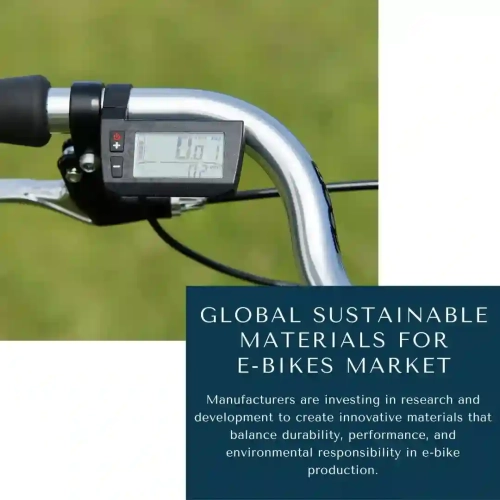SUSTAINABLE MATERIALS FOR E-BIKESMARKET
KEY FINDINGS
- The Global Sustainable Materials for E-Bikes Market from 2024-2030 showcases a shift towards eco-friendly manufacturing, emphasizing materials like recycled aluminum and biodegradable plastics.
- Increased consumer awareness about environmental impact drives demand for e-bikes made from sustainable materials, promoting a circular economy and reducing carbon footprint.
- Manufacturers are investing in research and development to create innovative materials that balance durability, performance, and environmental responsibility in e-bike production.
- Collaborations between industry players and sustainability organizations lead to the adoption of stricter standards for sourcing and manufacturing sustainable e-bike materials.
- Governments incentivize the use of sustainable materials in e-bike production through tax breaks and subsidies, fostering a more sustainable transportation ecosystem.
- Brands differentiate themselves by highlighting their commitment to sustainability, attracting environmentally conscious consumers and driving market growth.
- Technological advancements enable the production of lightweight yet durable sustainable materials suitable for e-bikes, enhancing performance and efficiency.
- Supply chain transparency becomes a priority as consumers demand traceability of materials used in e-bike manufacturing, driving industry-wide accountability.
- Adoption of sustainable materials in e-bike production leads to reduced waste generation and lower reliance on finite resources, contributing to a greener future.
- The Global Sustainable Materials for E-Bikes Market experiences steady growth as sustainability becomes a central focus for both consumers and industry stakeholders, shaping the future of urban mobility.
SUSTAINABLE MATERIALS FOR E-BIKES MARKET OVERVIEW
- The Global E-Bike Market is booming, fueled by a desire for sustainable transportation. To keep up, manufacturers are turning to sustainable materials for e-bikes.
- E-bikes themselves are eco-friendly, reducing emissions and traffic congestion. But the materials used to build them also matter. Lightweight yet durable options are key.
- Aluminum alloys are a popular choice. They offer a good balance of strength and weight, making for a more efficient ride. Plus, aluminum is recyclable, minimizing environmental impact.
- Carbon fiber is another lightweight champion. It's incredibly strong, allowing for thinner frames without sacrificing performance. However, carbon fiber production can be energy-intensive, so responsible sourcing is crucial.
- Bio-based materials are emerging as a sustainable alternative. Materials like bamboo and flax fibers offer potential for lighter, eco-friendly e-bike frames. Research and development in this area are ongoing.
- Beyond the frame, sustainable options extend to other e-bike components. Recycled plastics are finding their way into fenders, chain guards, and other parts.
- Even tires are getting a green makeover. Manufacturers are exploring recycled rubber and puncture-resistant bio-composite materials.
- The growing demand for sustainable e-bikes is pushing innovation. Battery recycling is another area of focus, ensuring a longer lifespan for these crucial components.
- Governments are playing a role too. Regulations and incentives are promoting the use of sustainable materials in e-bike production.
- As sustainability becomes a top priority, the market for sustainable materials in e-bikes is poised for significant growth in the coming years.
- This shift towards eco-friendly e-bikes benefits not just the environment, but also riders. Sustainable materials can lead to lighter, more efficient, and higher-performing e-bikes.
INTRODUCTION TO SUSTAINABLE MATERIALS FOR E-BIKES MARKET
Sustainable materials for e-bikes encompass a range of environmentally friendly substances used in the manufacturing of electric bicycles. These materials are typically sourced from renewable or recycled sources, aiming to minimize the ecological footprint associated with e-bike production. Common types include recycled metals such as aluminum and steel, bamboo, sustainably harvested wood, biodegradable plastics, and bio-based composites. Each material offers unique properties that contribute to the overall sustainability and performance of e-bikes.
The benefits of using sustainable materials for e-bikes are multifaceted. They include reduced carbon emissions and energy consumption during manufacturing, decreased reliance on finite resources, and minimized environmental degradation. Additionally, sustainable materials often result in lighter-weight e-bikes, improving energy efficiency and extending battery life. From a consumer perspective, e-bikes made from sustainable materials appeal to environmentally conscious individuals who seek eco-friendly transportation options.
Read our report about Global E Bike Drive Market 2024-2030
However, there are also risks and challenges associated with the adoption of sustainable materials in e-bike manufacturing. These include higher initial costs due to limited availability and higher production expenses compared to conventional materials. Quality control and durability are also concerns, as some sustainable materials may not offer the same level of performance or longevity as their traditional counterparts. Additionally, ensuring the traceability and ethical sourcing of sustainable materials presents logistical challenges for manufacturers, requiring transparent supply chains and compliance with stringent sustainability standards.
SUSTAINABLE MATERIALS FOR E-BIKES MARKET SIZE AND FORECAST

The Global Sustainable Materials For E-Bikes Market accounted for $XX Billion in 2023 and is anticipated to reach $XX Billion by 2030, registering a CAGR of XX% from 2024 to 2030.
SUSTAINABLE MATERIALS FOR E-BIKES MARKET TRENDS
- Innovative Recycling Techniques: Companies are increasingly exploring advanced recycling methods to extract and repurpose materials like aluminum and plastics, reducing waste and promoting a circular economy within the e-bike industry.
- Bio-Based Composites: The use of bio-based composites derived from natural fibers such as bamboo and hemp is gaining traction, offering a lightweight and environmentally friendly alternative to traditional materials in e-bike frames and components.
- Sustainable Battery Technologies: Manufacturers are investing in research to develop batteries with reduced environmental impact, including recyclable materials and improved energy efficiency, enhancing the overall sustainability of e-bikes.
- Urban Mobility Solutions: With a growing emphasis on sustainable urban transportation, e-bikes made from sustainable materials are becoming increasingly popular as eco-friendly alternatives to cars and public transit.
- Consumer Education and Awareness: There's a rising awareness among consumers about the environmental impact of their purchasing decisions, driving demand for e-bikes made from sustainable materials and prompting manufacturers to prioritize transparency and eco-friendly practices.
SUSTAINABLE MATERIALS FOR E-BIKES MARKET NEW PRODUCT DEVELOPMENT
Tesla, Inc.introduced the "Tesla EcoRide." This innovative e-bike features a sleek design crafted from lightweight yet durable sustainable materials, including a frame made from recycled aluminum and bio-based composite components. With a focus on sustainability, the Tesla EcoRide boasts a powerful electric motor powered by a sustainable battery pack utilizing advanced lithium-ion technology with recyclable materials. Equipped with smart sensors and connectivity features, the EcoRide offers seamless integration with Tesla's ecosystem, providing riders with real-time performance data and navigation assistance.
Bosch eBike Systemsintroduced the "Bosch GreenRide." This eco-conscious e-bike boasts a frame constructed from responsibly sourced bamboo, providing both strength and a distinctive aesthetic appeal. The GreenRide is powered by Bosch's innovative sustainable battery solution, featuring high-energy-density cells made from recycled materials, ensuring long-lasting performance while minimizing environmental impact. Equipped with Bosch's advanced motor system, the GreenRide offers smooth and efficient pedal assistance, making it ideal for urban commuting and leisurely rides alike.
VanMoofintroduced the "VanMoof EarthCycle." This cutting-edge e-bike features a frame crafted from recycled aerospace-grade aluminum, providing exceptional durability and lightweight performance. The EarthCycle is powered by VanMoof's advanced sustainable battery technology, utilizing high-capacity cells made from ethically sourced materials and boasting an extended lifespan. Equipped with integrated smart features such as GPS tracking and anti-theft protection, the EarthCycle offers a seamless and secure riding experience for urban commuters and eco-conscious riders.

SUSTAINABLE MATERIALS FOR E-BIKES MARKET SEGMENTATION
By Geography:
- USA
- Europe
- China
- Asia Excluding China
- Rest of the World
By Material Type:
- Aluminium Alloys
- Carbon Fibre
- Bio-based Materials (bamboo, flax fibres, etc.)
- Recycled Plastics
By E-Bike Component:
- Frame
- Fenders & Chain Guards
- Tires
- Battery
By E-Bike Type:
- Mountain E-bikes
- Road E-bikes
- Hybrid E-bikes
- Cargo E-bikes
Know more about Europe E-Bike Market
SUSTAINABLE MATERIALS FOR E-BIKES MARKET COMPANY PROFILES
- Trek Bicycle Corporation
- Giant Manufacturing Co., Ltd.
- Specialized Bicycle Components, Inc.
- Cannondale Bicycle Corporation
- Riese & Müller GmbH
- Gazelle Bicycles
- Moustache Bikes
- BULLS Bikes USA
- VanMoof
- Rad Power Bikes
SUSTAINABLE MATERIALS FOR E-BIKES MARKET REPORT WILL ANSWER THE FOLLOWING QUESTIONS
- What are the primary sustainable materials used in the manufacturing of e-bikes?
- How do sustainable materials contribute to reducing the environmental impact of e-bike production?
- What are the key drivers behind the growing demand for e-bikes made from sustainable materials?
- How do regulations and government policies influence the adoption of sustainable materials in the e-bike market?
- What role do consumer preferences and awareness play in shaping the market for sustainable e-bike materials?
- What innovative recycling techniques are being employed to create sustainable materials for e-bikes?
- How do bio-based composites compare to traditional materials in terms of performance and sustainability?
- What are the challenges associated with sourcing and manufacturing sustainable materials for e-bikes?
- How do sustainable battery technologies impact the overall sustainability of e-bikes?
- What collaborations and partnerships are driving innovation in sustainable e-bike materials?
- What are the cost implications of using sustainable materials in e-bike manufacturing?
- How do companies ensure the traceability and ethical sourcing of sustainable materials for e-bikes?
- What advancements are being made in lightweight sustainable materials for e-bike frames and components?
- How does consumer education and awareness influence the market for sustainable e-bike materials?
- What role does supply chain transparency play in promoting the adoption of sustainable materials in the e-bike industry?
- What strategies are manufacturers employing to address the durability and quality concerns of sustainable materials?
- How do sustainable e-bike materials contribute to extending battery life and improving energy efficiency?
- What impact does the availability of sustainable infrastructure have on the growth of the e-bike market?
- How are companies differentiating themselves in the market for sustainable e-bike materials?
- What are the emerging trends in sustainable materials for e-bikes beyond 2030?
- What market segments show the highest demand for e-bikes made from sustainable materials?
- How do market dynamics vary across different regions in terms of sustainable e-bike materials?
- What opportunities exist for startups and small companies in the sustainable e-bike materials market?
- How do advancements in material science contribute to the development of sustainable e-bike materials?
- What are the environmental benefits of using e-bikes made from sustainable materials compared to other forms of transportation?
- What challenges do manufacturers face in scaling up production of e-bikes using sustainable materials?
- How do consumer preferences for customization and personalization impact the demand for sustainable e-bike materials?
- What role do industry associations and organizations play in promoting the use of sustainable materials in e-bike manufacturing?
- What strategies are companies employing to communicate the sustainability benefits of their e-bikes to consumers?
- How do economic factors and market trends influence the adoption of sustainable materials in the e-bike industry?



